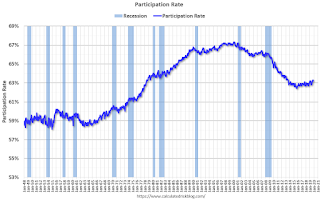by Calculated Risk on 1/01/2020 02:55:00 PM
Wednesday, January 01, 2020
Question #3 for 2020: What will the unemployment rate be in December 2020?
Earlier I posted some questions for next year: Ten Economic Questions for 2020. I'm adding some thoughts, and maybe some predictions for each question.
3) Unemployment Rate: The unemployment rate was at 3.5% in November, down 0.2 percentage points year-over-year. Currently the FOMC is forecasting the unemployment rate will be in the 3.5% to 3.7% range in Q4 2020. What will the unemployment rate be in December 2020?
This first graph shows the unemployment rate since 1948.
The unemployment rate has declined steadily after peaking at 10% following the great recession.

The current unemployment rate (3.5%) is below the low (3.8%) at the end of the '90s expansion, and at the lowest rate since 1969.
As I've mentioned before, current demographics share some similarities to the '60s, and the unemployment rate bottomed at 3.4% in the '60s - and we might see the unemployment rate that low or lower in this cycle. If we look further back in time, the unemployment rate was as low as 2.5% in the 1950s.
Forecasting the unemployment rate includes forecasts for economic and payroll growth, and also for changes in the participation rate.
On participation: We can be pretty certain that the participation rate will decline over the next decade or longer based on demographic trends. However, over the last several years, the participation rate has been fairly steady as the strong labor market offset the long term trend.

The participation increased significantly starting in the late 60s as the Boomer generation entered the workforce and women participated at a much higher rate.
Since 2000, the participation rate has generally declined, mostly due to demographics.
Here is a table of the participation rate and unemployment rate since 2008.
| Unemployment and Participation Rate for December each Year | |||
|---|---|---|---|
| December of | Participation Rate | Change in Participation Rate (percentage points) | Unemployment Rate |
| 2008 | 65.8% | 7.3% | |
| 2009 | 64.6% | -1.2 | 9.9% |
| 2010 | 64.3% | -0.3 | 9.3% |
| 2011 | 64.0% | -0.3 | 8.5% |
| 2012 | 63.7% | -0.3 | 7.9% |
| 2013 | 62.9% | -0.8 | 6.7% |
| 2014 | 62.8% | -0.1 | 5.6% |
| 2015 | 62.7% | -0.1 | 5.0% |
| 2016 | 62.7% | 0.0 | 4.7% |
| 2017 | 62.7% | 0.0 | 4.1% |
| 2018 | 63.1% | 0.4 | 3.9% |
| 20191 | 63.2% | 0.1 | 3.5% |
| 12019 is for November 2019. | |||
Depending on the estimate for the participation rate and job growth (next question), it appears the unemployment rate will decline into the low 3's by December 2020 from the current 3.5%. My guess is based on the participation rate declining slightly in 2020, and for decent job growth in 2020, but less than in 2019. If I'm wrong about the participation rate (the start of the decline might be delayed for another year or so), then the unemployment rate will likely be in the mid 3% range by December 2020.
Here are the Ten Economic Questions for 2020 and a few predictions:
• Question #1 for 2020: How much will the economy grow in 2020?
• Question #2 for 2020: Will job creation in 2020 be as strong as in 2019?
• Question #3 for 2020: What will the unemployment rate be in December 2020?
• Question #4 for 2020: Will the overall participation rate start declining in 2020, or will it move more sideways (or slightly up) in 2020?
• Question #5 for 2020: How much will wages increase in 2020?
• Question #6 for 2020: Will the core inflation rate rise in 2020? Will too much inflation be a concern in 2020?
• Question #7 for 2020: Will the Fed cut or raise rates in 2020, and if so, by how much?
• Question #8 for 2020: How much will RI increase in 2020? How about housing starts and new home sales in 2020?
• Question #9 for 2020: What will happen with house prices in 2020?
• Question #10 for 2020: Will housing inventory increase or decrease in 2020?


